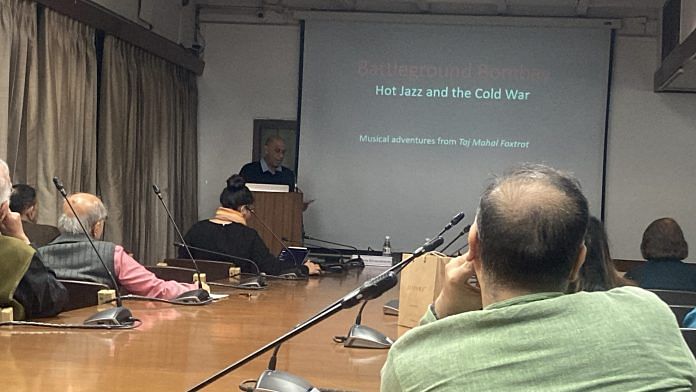New Delhi: During the Cold War, the Americans launched a musical missile to convince the world of their cultural superiority over the Russians: jazz. And India was ground zero — it turned into a musical battleground.
At the first of a lecture series organised on 22 February 2024 by the American Institute of Indian Studies (AIIS) and the India International Center (IIC), Naresh Fernandes, Editor, scroll.in, brought the Bombay of the ’50s and ’60s alive through songs, video recordings, and press clippings.
Fernandes, who is also the author of Taj Mahal Foxtrot: The Story of Bombay’s Jazz Age (2017), has been building a musical archive of jazz in India, crystallising swinging Bombay in a moment in time. This lecture, titled ‘Battleground Bombay: Hot Jazz and the Cold War, Musical Adventures from Taj Mahal Foxtrot’, in collaboration with the AIIS’s Archives and Research Centre for Ethnomusicology, looked at how and why jazz came to Bombay in the first place — as an instrument of propaganda.
“America’s public image in the developing world needed a little spit and polish — and so the US decided to send artists around the world to demonstrate that Americans were open and fun, superior to namby-pamby ballet,” explained Fernandes.
His point rang loud and clear through the photographs and videos he used to illustrate the lecture. The room listened spellbound as the most famous jazz musicians of all time — Louis Armstrong and Dave Brubeck — explained it themselves in their song Cultural Exchange:
“The State Department has discovered jazz/ It reaches folks like nothin’ ever has!/Like when they feel that jazzy rhythm/ They know we’re really with ’em/ That’s what we call cultural exchange!”
Swinging Bombay
Bombay was not immune to jazz.
“I have seldom seen an Indian audience this enthusiastic!” declared Russi Karanjia in Blitz, after attending a Red Nichols concert at the St. Xavier’s Quadrangle in 1960.
Things really took off in the early 1960s, by which point Bombay had been listening to jazz for at least 30 years. Dave Brubeck had held a huge concert at the Brabourne Stadium, which left a huge impact on listeners. Duke Ellington, who came later in the 1960s, has written extensively about his experiences in India — and was even responsible for getting the State Department to lower the ticket prices for musicians who couldn’t afford to attend these huge concerts.
When Louis Armstrong visited Bombay in December 1964, his concert was packed — even though Bombay was also hosting a papal congregation at the same time, beating concerns that audiences would choose to see the Pope instead. Though Armstrong’s tour wasn’t part of the State Department’s programme, the US organised and publicised the concert as if it was.
The radio network, Voice of America, also broadcast jazz, and Indian listeners would tune in beyond the Iron Curtain as early as 3:30 am IST to listen.
But there was also some suspicion over the American agenda — spearheaded by Blitz’s wily journalists. “No Indian attending these whoopees return home without feeling Americans are their blood brothers,” commented one Blitz editor.
And their suspicions were confirmed years later when news came out that the Central Intelligence Agency (CIA) was, in fact, funding these musical tours.
Jazz as a cultural export
Sending jazz musicians on world tours was an early form of cultural diplomacy, meant to counter the aggressive reputation the US was building for itself.
“It was the only homegrown art form the US could boast of — and more importantly, it was an African-American art form,” said Fernandes.
And so dispatching jazz musicians across the world gave Washington DC a chance to say that things were not so bad in America, just as the civil rights movement unfolded. Brubeck, Armstrong, Ellington, Red Nichols and others travelled too, performing in big cities and drawing hundreds in crowds.
Brubeck and Armstrong formed a group called ‘The Real Ambassadors’ in response to the civil rights movement. While jazz tours were warming the hearts of elite audiences around the world, jazz musicians in America were becoming increasingly disgruntled with the State Department. The diplomats they met in countries like Iraq and Indonesia were old-school racists, treating them with condescension — many felt it was hypocritical for the State Department to rely on African American musicians to spread a cultural message across the world when they weren’t yet allowed voting rights in parts of the American South.
“I’m a musician, but didn’t know about this aspect of cultural messaging,” said an audience member associated with the AIIS’s Center for Ethnomusicology. “So it was interesting to learn about how jazz took root in India through American foreign policy.”
So, did the agenda work in India? Fifty years later, fans still remember the warmth and excitement of jazz, as the audience at the IIC talk proved. Many greyheads were bobbing and feet were tapping as audience members recognised the tunes Fernandes was playing.
“In the end, it was a bold piece of diplomacy, showcasing American culture with all its contradictions,” concluded Fernandes. “It helped many Indians realise that even if we despise American foreign policy, American people themselves were actually normal.”
(Edited by Humra Laeeq)
Also read: This artist imagines India and Italy as neighbours. He’s inspired by his teacher Osho



